Introduction
In Gwent: The Witcher Card Game by carryover we mean effective value transferred from current to later round(s). This mechanic is not essential, but adds additional complexity to the game.
Carryover cards could be viewed as a kind of investment made for later rounds at the expense of temporary value. In this article we would look deeper into carryover mechanic.
Types Of Carryover In Gwent (10.10)
In the current state of the game, there are multiple and varied ways of obtaining carryover value. Let’s explore these possibilties before moving into deeper analysis and case studies.
- Handbuff Carryover
Carryover value is obtained by buffing a card in hand which gets preserved for a later round. The carryover agent is usually a single card playing for raw value below the power vs provision curve. The characteristic features of Handbuff Carryover are often units going tall and the necessity to keep handbuff target cards in hand. Examples: Farseer in Handbuff Invigorate, Enchanted Armor stratagem, Circle of Life in Devotion Nature’s Gift, Dunca, Fiend in a Deathwish deck…
- Deckbuff Carryover
Boosting units in the deck. Typical features: low tempo, generated value is often not directly accessible. Examples: Allgod, Erland of Larvik (in this case value is accessible via order click), Mutagenerator…
- Resilient Unit Carryover
Units with resilience status contribute value to the next round. Features: initial power below the curve, combined value spread over rounds lying on or above the curve, very low flexibility. Examples: Ciri:Nova, Vandergrift,…
- Location Carryover
While locations carryover also rely on resilience status, their full value is directly accessible in the same round as soon as Order becomes active. Therefore locations must have lower value / higher provision when compared with Resilient Units. Examples: Mushy Truffle, Tir Na Lia, War Council…
- Payoff Carryover
Increasing value of particular payoff cards in later rounds. Examples: Chameleon clicks increasing Lake Guardian value, specials increasing Harald Gord value, bounties decreasing Ignatius Hale tribute…
- Spawning Copies Into The Deck
Spawning copies of a bronze unit into the deck with the possibility of summoning all copies at once. In Gwent 10.10 this carryover type is unique for Northern Realms and cards like Blue Stripes Commandos, multiplied by Blue Stripes Scouts and other tools. Copies could be summoned immediately or kept in the deck. If summoned immediately, then there is no real carryover generated until the copies get shuffled back into the deck with Princess Pavetta.
A slightly different kind of spawning copies into the deck is Vanadáin + Simlas combo. There is intermediate stage of copying cards into hand – each commitment of Waylay from hand means a severe carryover loss. Therefore Alissa Henson is often played for more flexibility in Waylay use – if commitment is necessary, then Waylay would be shuffled back into the deck from graveyard and Simlas would still play for full value.
- Shuffle-back Carryover
Shuffling strong cards from graveyard (Lippy Gudmund, Assire Var Anahid, Alissa Henson…) or from board (Decoy, Yennefer’s Invocation…) into the deck.
- Graveyard Setup Carryover
Round 1 and Round 2 could be used to setup graveyard for future benefit. Usually specific trigger is needed. For example increased base value is a form of carryover gained by Melusine and could be triggered with Sigdrifa’s Rite and Fucusya. Addtional copies of Crow Messengers in Skellige could be setup on graveyard with cards like Operator and Megascopes; the trigger could be Freya’s Blessing. High base value Selfeater could be setup on graveyard in a Relicts deck (possibly with Operator) and summoned by Incubus in a later round. Orbs of Insight could be setup on graveyard in Scoia’tael decks and triggered with a special card…
- Deck Manipulation Carryover
Improving own deck structure, or worsening of opponent’s one. Improving includes cards like Fisher King, Maxii van Dekkar or Jan Calveit, worsening for example mill (Traheaern, Kingslayer, Ihuarraquax) or clogging cards (Infiltrator, Coated Weapons, Viper Witcher).
- Thinning Carryover
A hidden type of carryover – thinning improves odds of drawing crucial cards and makes deck control easier. At the moment this article is written (Gwent 10.10), a single thinning carryover value could be assessed as ~1.5 raw points value (check out GM&P5: Thinning monograph). Examples: Archespores, Mask of Uroboros stratagem, Heymaey Skald,…
- Coins Carryover (Syndicate)
Saving half of the coins in the pouch (rounded down), it is possible to carryover up to 4 coins to the next round. Depending on spenders availability and their efficiency, those coins could be exchanged into various point value. This natural ability of Syndicate usually let’s carryover to be established at will on red-coin. Recurring motif is saving coins in the poach while keeping point reach and passing only when closing the gap becomes too expensive.
- Anti-carryover
Denying opponent’s carryover possibilities is effectively no different to gaining own carryover. For example Squirrel played to spoil opponent’s Graveyard Setup Carryover is nothing else than a low tempo carryover card.
- And many more…
Squire order effect carries over to the next round. Radovid adds one leader charge on deploy and additional one if order gets through, Highland Warlords add +1 damage to every Raid card … The carryover tools in Gwent (10.10) are rich and varied. Enumerating all possibilities is not the purpose of this article. It is also worth noting that most cards with carryover effects were not present in Gwent Homecoming after release, but only added later on with expansions.
Carryover Space
By defnition, carryover value could be established only in Round 1 and Round 2. Whenever a card of carryover type is found or played in Round 3, it would usually play below Power vs Provision curve.
The scale of the drawback depends on the carryover type. Resilient units often offer strong carryover value, but when played in Round 3, they are very underwhelming. For example the power of resilient knight Vandergrift at 9 provision cost is lower than average 4 provision meta card (Gwent 10.10). Similarily Graveyard Setup Carryover cards, like Crowmother or Operator into Crow Messenger, would be weak and overcosted in Round 3.
On the other hand, many Location Carryover cards, like Mushy Truffle, would still provide a decent value, maybe only slightly below the curve at times.
The necessity of drawing carryover cards early is the permanent bottleneck of the mechanic. The chances to find a single card before Round 3 are equal to 67% in case of no thinning. The chances to draw the card exactly in R3 are 13%.
Using a single tutor elevates the R1/R2 drawing odds to 76/90%. If the carryover card is a win condition, then tutoring it is obligatory, way more than in the case of Round 3 win conditions (80% to find a single card during game; have a look at GM&P6: Tutors for more details).
Carryover cards sometimes need tutoring, but always need some space of opportunity provided by the builded deck and its general gameplan. Carryover card brings no value even if found Round 1 given that opponent would benefit more from round control offered by its low tempo. Imagine for example a Golden Nekker Relicts deck with Allgod playing on red coin against Knights with Yrden. To get any winning chances, Relicts have to apply pressure and bleed out Damsel in Distress scenario in Round 2. Playing for 4 tempo, no engine value and no control, Allgod would only make this task more difficult.
To maximize carryover space, gameplan should preferably include scenarios where carryover is playable in Round 2 as well. If Round 1 is won, it requires playing Round 2 and losing a card not being a real threat. Have a look at NR Knights deck as an example. With Aerondight and very strong Damsel in Distress opener, Vandergrift fits very well in Round 2 push strategy.
If Round 1 is lost, then carryover card has to be just strong enough to avoid 2:0 or bleeding out crucial cards. An example could be Ciri:Nova and Conjurer’s Candle in Lined Pockets Golden Nekker.
Always think exactly about moments and opportunities which will arise to play a carryover card in games against meta decks. Try to navigate the game in a way that generates space for them.
Gwentstone And Carryover
Let’s go back to the model game of Gwentstone introduced in the article ‘Bleeding & Pushing Or How To Play Round 2?‘.
There is a variant of this game where each player owns two sets of stones: 10 Big (‘golds’) and 15 Small (‘bronzes’). In addition to this, there are Special stones, which remain on the board for the next round.
How much is such a special stone worth? Let’s say its weight is W, weight of Big stones is \(W_B\), of Small \(W_S\). The difference in weight between B and S would be denoted as \(\Delta\).
Let’s say one of players (P1) used such special stone in Round 2 on drypass. To fit it, one of big stones in the deck had to be replaced. Their opponent (P2) plays a normal deck. Which player would on average win a long round 3 assuming that there was no commitment from both sides?
The special stone contributes additional value W to the next round hand, but at the expense of less golds available. We would not go into deeper calculations here, but only make use of the fact that 80% of golds is found every game. Then on average 7.2 could be expected in R3 in a deck with special card and 8.0 otherwise. If special stone got found, then power difference is:
\[ P_{found} = W – 0.8\Delta\]
If W is comparable or greater than Delta, then P1 is at slightly advantageous position. But there is a hack. The special card wouldn’t always be found up to R3 – as we said earlier, there is only 67% chance to find a single carryover card before R3. If carryover card isn’t stronger than the rest of the cards in R3, then in 1/3 of cases we have simply 8.0 vs 7.2 scenario without carryover. Finally we settle at sth like:
\[P_{general} = \frac{2}{3} (W – 1.2\Delta) \]
The weight of the special stone has to exceed big-to-small difference by some amount! Playing an expensive gold carryover card just for R2 drypass use is rarely a good idea!
Carryover Wins A Short Round
In the Gwentstone section we investigated how much carryover is needed from a single golden card to get a real long round 3 benefit.
Now let’s check out the opposing pole: how much carryover is needed to win a short round 3 everytime? Player P1 would push Round 2 while playing carryover cards. As a consequence, P1 would go to Round 3 a card down, hoping to win solely due to established carryover.
Proven that carryover could be transformed into immediate value, P2 would usually save only two strongest cards in hand (otherwise a hero-pass is needed), while A would keep one. Let’s say that the power of A and B last cards is even. Then the power of the second B card makes for the threshold.
Carryover consistently wins short Round 3 if stronger than second best pointslam card in meta decks.
Note that winning R1 on even while having strong carryover possibilities basically means winning the game as the second best card from the rule above would probably be forced out.
Imagine a duel of some Blue Stripes Renfri deck vs Relicts Renfri, where Renfri in both decks have similar power. After R2 push, Relicts could save Renfri and Mammuna for the final round. Mammuna value is equal to 20 points. How many Blue Stripes are needed in the deck to win the game? Probably more than 7, as only 5 Stripes then are real carryover (5*4=20), and 2 Stripes are about the power of normal 5 provision card.
If a deck could easily gather win-con level carryover in R2, then it couldn’t be let free. Round control is needed to prevent establishing carryover in Round 2 by opponent – either bleeding out the payoff or forcing long round is valid.
Including Carryover Cards
As said earlier, unless unbalanced, carryover cards should always be put in the gameplan context of the particular deck.
- Cheap (bronze) carryover tools
Cheap carryover cards could be great in red-coin decks, which are not afraid to lose R1 in most matchups. An example would be Highland Warlords in Blaze of Glory Devotion Warriors deck. The deck offers enough control thanks to damage and enough pointslam thanks to Eist+Jutta/Sove combo to not be afraid of long round, nor push in most matchups.
On blue coin, bronze carryover cards should also provide good points in the short term to avoid the risk of losing on even cards. An example of such card could be Chameleon in Harmony deck, which could play for Payoff Carryover with Lake Guardian, or Squire in NR Knights, which could pass infusion boost to the next round or not depending on circumstances.
Another good use of low provision carryover cards are drypass situations in Round 2. Questionable in decks prone to bleed, but possibly beneficial in midrange decks doing well in any round legth. An example of a card often used in such application is Maxii van Dekkar.
- Expensive (gold) carryover tools
As long as gold carryover card instant value lies on Power vs Provision curve, the card is simply a meta pick with additional flexibility. An example here is Mushy Truffle after the release in the Price Of Power expansion. Worth 9 provision, the card at least returned its provision cost in every game, while opening carryover play options at the same time. The card was autoinclude for one season until getting nerfed to 10 provision.
The evaluation made in ‘Gwentstone And Carryover’ section is the baseline for including a carryover card in a long round deck. You simply need something more than carryover value between two rounds closing point gap between bronzes and golds.
Very often though, the carryover is spread over both Round 2 and Round 3. For example Crowmother when played in Round 1, could bring extra points whenever Round 2 is played actively. On the other hand, when Round 1 couldn’t be contested and long round 3 is won by most meta decks, Crowmother could easily become obsolete in an Alchemy deck, and for example some long round control tool, like Geralt:Yrden would be played instead.
Gold carryover cards not exceeding golds-to-bronzes gap would seldomly be meta definers. On the other hand, the ones crossing the gap become the center of attention. They have to be controlled on the early stage, which leads to binary, draw dependent scenarios. Have a look at the carryover section of ‘When Gwent Meta Goes Wrong’ article.
Melusine with Sigrdrifa’s Rite and Fucusya, or King Foltest with Blue Stripes (before 10.10 also with Renfri’s Gang) could easily outgrow the gap and become staple whenever the meta lacks necessary control tools.
Evaluating Chosen Carryover Cards
(Gwent 10.10)
- King Foltest

At 11 provision cost, King Foltest is a very expensive gold card, which should play for about 15 effective points to keep up with power vs provision curve.
The +1 boost effect is very weak by itself, and the power of spawn a copy effect depends on target card. Let’s consider a non-devotion Blue Stripes deck for the rest of the discussion. After the initial turn, Foltest is worth 5(base)+1(boost)+4(carryover) = 10 points. Foltest is effectively a +5 per turn engine, out of which +4 is carryover, which may, or may not be used in the same round.
Moreover, with Pavetta shuffle-back, the carryover counts twice. Each Foltest’s spawn of a copy is then effectively worth +8 in the long run. Even more if payoff cards like Voymir or Lyrian Scytheman are played.
Seeing Foltest as +8 per turn carryover engine though is deceiving, as we have to keep in mind what is the starting point for Blue Stripes combo. With 6 base power and 8 provision cost, Pavetta plays 6 points below power vs provision curve. Blue Stripes Commando pair itself is worth 8 points for 6 provision, which is about 3 points below the curve. Another non-zero cost comes with Inspired Zeal leader; in Gwent 10.10 meta level leaders are capable of generating about ~12 effective points. Having to use Zeal only as Commando triggers make this leader ability play ~6 points less.
Then while Foltest is powerful carryover engine by itself, the archetype he supports make him (and Blue Stripes Scouts) start carryover job from about -15 points initial level.
For optimal value, King Foltest must be found in Round 1. Cursed Scroll is considerable on blue coin, on red each next tutor improves chances like 48%/74%/88%. The necessity to play a tutor is another additional cost associated with Foltest in a Blue Stripes deck, making carryover starting point even lower.
It is also worth noting that exact point count doesn’t matter that much as long as Round 1 could be won, and ‘Carryover Wins A Short Round’ scenario could be realized.
- Melusine

Introduced in the Price of Power expansion, Melusine is an engine card with multiple interesting effects: spawning Rain, damaging self and neighbouring units and finally increasing self base power for each neighbouring unit.
After full development, Melusine becomes +2 per turn Graveyard Setup Carryover engine. The primary trigger to unleash carryover value is Sigdrifa’s Rite and secondary Fucusya (because of lost rain value). The drawback is going tall and proness to graveyard hate.
The engine value of Melusine is complex, highly dependent on the card pool and meta. Just to get a number, let’s assess it as +1.5 per turn.
Without carryover possibilities and extra synergies, Melusine is a bit overcosted, low ceiling, mediocre floor engine. Only carryover possibilities make the card outstandingly significant. Let’s estimate carryover ceiling. First round 1 is played down to 1 card (10 turns) – Melusine could reach 27 base value. Then Sigdrifa is played in Round 2 as 27 for 8 and Melusine has to be purified in the same round to enable Round 3 carryover. Player drops 3 out of 4 cards, opponent 4 cards, Round 2 lasts 5 turns, Melusine grows like 0,1,2,2,2 = 7 points. Then in Round 3 Melusine is played from Fucusya at 34 points (+4 from Fucusya = 38).
Let’s say that 12 for 8 and 20 for 14 are power vs provision curve values. Then Melusine played for total carryover of (27-12) + (38-20) = 33 points. The Round 3 carryover value alone may not always be enough to win a card down (+18, sometimes less than best secondary pointslam card). On the other hand, combined R2 and R3 value would be almost always enough. The only requirement is no direct counter from opponent – no tall punish and no graveyard hate.
- Farseers in Invigorate
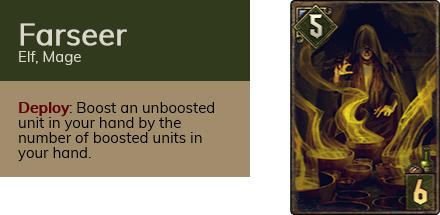
After double Invigorate leader use in a long round, Farseer could boost an unit in hand by 8 points. At 6 provision cost, 13 points raw combined value lies on Power vs Provision curve.
A card boosted by Farseer could be viewed as +8 power +2 provsion (as effective Farseer cost is 6-4=2). If played purely for carryover, Farseer offers only 5p tempo which below 4 provision cards value. Moreover, Farseer loses value with the round length – if opponent starts with engines, then it is impossible to play Farseer and answer them at the same time.
Therefore, to make real carryover use from Farseer, Invigorate deck has to be ready to lose Round 1 in many matchups. Thanks to good overall value though, being forced to spend carryover in Round 1 doesn’t make Farseer sub par.
The buff of +8 is a very channeled one and potentially could mean +0 when subjected to tall punish. Finding good target matters for real carryover value. The usual target guaranteed in Round 1 is Torque. Boost from Farseer is then repeated by Torque on a random card in hand.
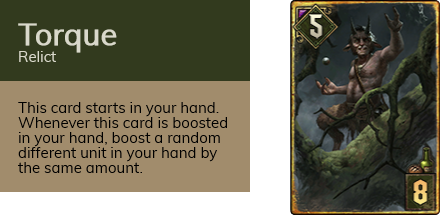
One may think that Farseer plays even as 16 points of carryover, but such estimate is overshoot in a way similar to King Foltest. Torque starts as 5 for 8. Handbuff from Farseer makes it play as about 13 for 8, which is on Power vs Provision curve. Then Farseer indeed played as something like 16 carryover, but 8 points of those were used to bring Torque to power vs provision curve.
- Mutagenerator
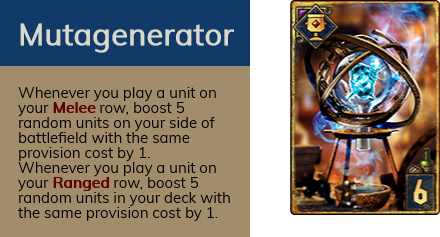
Mutagenerator is a zero tempo artifact with very high point generating potential for 6 provision.
Being able to play down to 4 cards in Round 1 potentially gives 5×5=25 points of carryover. Playing down to 0 could bring 45 points. Moreover, at the expense of no carryover value, Mutagenerator could function as a strong engine when units are played in the melee row.
To develop full carryover value, 5 units of the same provision cost as the played unit has to be present in the deck. Therefore the deck has to play at least 6 same provision units to have a chance of getting full +5 carryover value at least once. It is the deckbuilding cost of playing Mutagenerator, which as in the case of King Foltest, lowers the starting point for carryover; Mutagenerator deck usually would be weaker than non-Mutagenerator one, and the difference would be more than just +2 provision cost.
In practice providing enough same provision cards is possible mostly in 4-5 provision range. The hack then is that 1) carryover is placed on cards which usually would be outside Execution Team in normal decks, 2) those cards have to be found and played if carryover is supposed to be full. Also spreading the buff on more than exactly 5 low provision cards often would be a waste.
Mutagenerator decks shouldn’t be afraid of taking long rounds in most matchups; otherwise going deep in Round 1 after opponent’s early pass is not possible. Good amount of greed and control is needed.
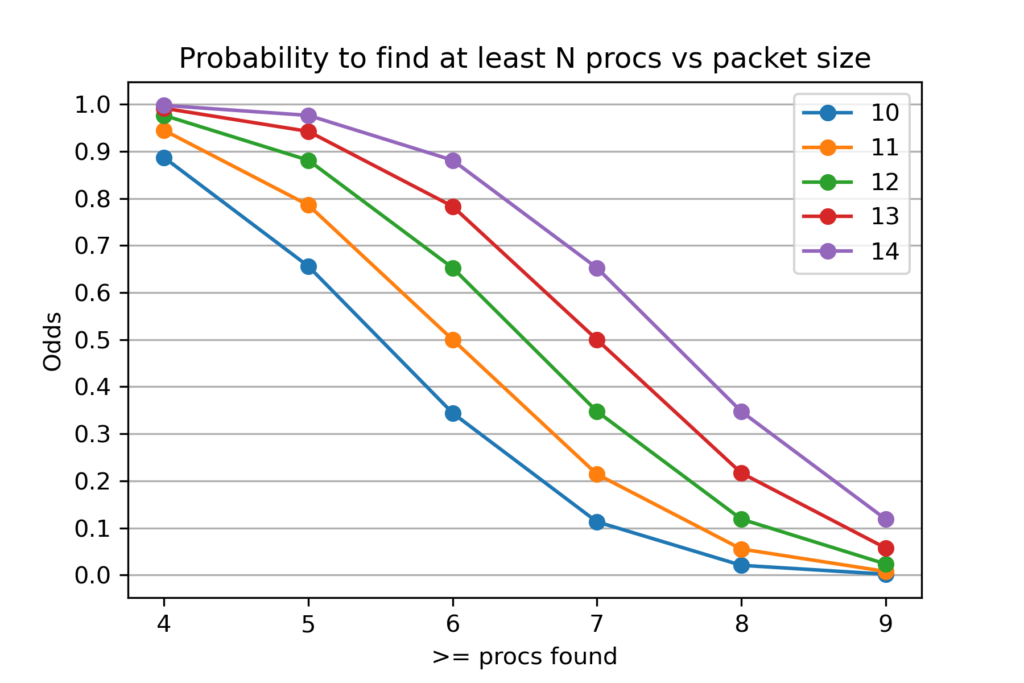
Getting carryover procs for a provision group doesn’t have to rely on playing units from this group. Spawning and playing any unit of same provision cost also works; cards like Mushy Truffle, Garrison or Reinforcements could work as additional procs, while keeping the provision packet in the deck slim and carryover less dispersed.
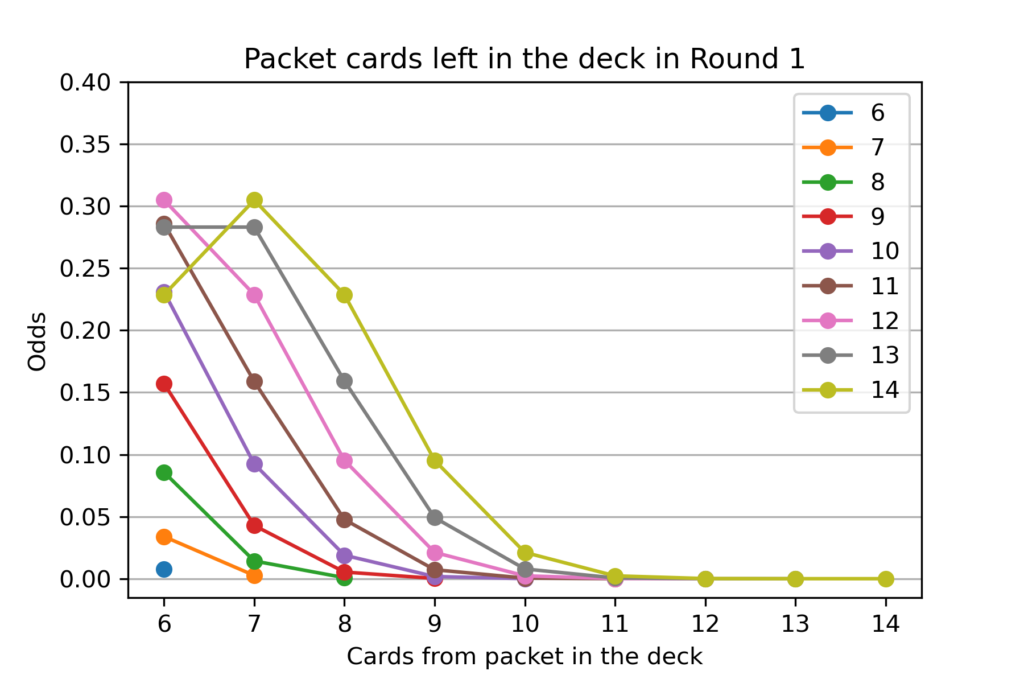
(neglecting cards mulled out from initial hand) Ideal packet size should be a compromise between the number of accessible procs and carryover dispersion. Alternatively, Erland of Larvik could be played to gather all carryover boosts rather than making use of all boosted cards.
Closure
Time to finish this part of Gwent Pro Tutorial cycle. Hope you enjoyed the lecture. Let me know what could be improved and what topics would you like to see in the next chapters of the cycle.
The basic conclusion to draw from this tutorial – always think of carryover in the context of your gameplan and meta! While Poinstlam cards are simply strong or weak, basic Control and Engines trade well or badly in the meta, the Carryover above all needs space to be played. Of course, some carryover tools like Ciri:Nova or Shupe:Knight into Resilience are objectively strong, but only playspace make them really shine!

